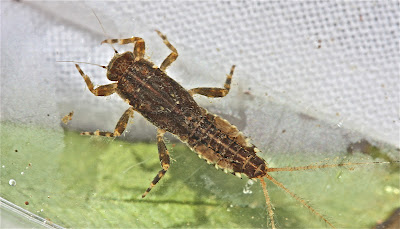Wednesday, March 7, 2012
The Freeliving Caddisfly Rhyacophila carolina in Whippoorwill Branch
I made a quick trip to the Whippoorwill Branch of the Mechums this afternoon, and while most everything that I found was expected, this one was not: the freeliving caddisfly Rhyacophila carolina -- this is the first time I've identified this species in one of our streams. And I picked up two of them. The second was, in comparison with the one in the photo above, shorter, fatter, and darker in tone.
But it's clear that the two are the same; just look at the heads and the pronotums -- golden brown. Beaty notes that R. carolina is the "second most common Rhyacophila in NC," with the golden brown head being the key feature to see. The other feature that is key to identification -- there are no ventral teeth on the anal claws. The photo below bears this out.
This is the fourth freeliving caddisfly species that I've been able to ID in local streams, the other three being R. fuscula (most common), R. nigrita, and R. glaberrima, all of those found in the small stream in Sugar Hollow to which I seem to return a couple of times each month. Relevant entries on those other species were posted on 11/25, 12/26, and 2/13.
My goal today was to find some common netspinner larvae: I've got the itch to work at species ID on the common genus Hydropsyche. Well, I did find common netspinners -- a lot of them in fact -- but number one, they were all very small, and number two they were all genus Cheumatopsyche, which Beaty advises us to leave at the level of genus! So it goes. A couple of photos of a Cheumatopsyche common netspinner larva.
Like Hydropsyche netspinning larvae, Cheumatopsyche larvae have a "forked fore trochantin."
But we distinguish the two genera by looking at the prosternal plate (under the chin). Hydropsyche larvae have two small sclerites (dark patches) right below the prosternal plate; Cheumatopsyche larvae do not. This larva was Cheumatospsyche.
While I can't support this with data, my impression is that the majority of the common netspinners we find are Hydropsyche, but you can't really tell without looking under the chin.
Cheumatopsyche common netspinners are very tolerant, with a generic tolerance value of 6.6. Odd that I find these side-by-side with the freeliving caddisfly larva R. carolina, which has a tolerance value of 0.4.
__________
The "Spiny Crawler explosion" is well under way in this stream: patches of moss on the rocks (under the water) were loaded with them. Most were still very small. But I did find one that I could photo. This is our common spring species E. dorothea.
And one other interesting photo. I found a lot of Uenoid case-makers with their little stone cases clinging to rocks. One of them slipped out of its case and started crawling around on a caddis pupa that I had picked up!
The pupating caddis was either a fingernet caddis or a freeliving caddis -- but I didn't feel like opening up the cocoon so I could find out.
_____________
The two R. carolina larvae come face-to-face in my tray.
Subscribe to:
Post Comments (Atom)










I am enjoying your observations... and photos... I miss the Appalachian fauna.
ReplyDeleteA few observations...
The Rhyacophila make those nice neat silk pupual cases... also, Glossosomatids make similar pupal cases, but theirs are shorter and rounder... Hydropsyche/Cheumatopsyche are much "sloppier."
The sclerites on Hydropsyche are usually hidden under the roll of skin behind behind the prosternum. In your photo, you can see it coming forward from the mesosternum where it would cover the plates. So... that picture could be of Hydropsyche... (not saying you are wrong, you may have looked behind the roll of skin and seen no plates there... just that the photo is not necessarily indicative Cheumatopsyche)
I would not be surprised to find tolerant and sensitive critters in the same stream. I often remind watershed groups that there are no "bad bugs" in streams. Many tolerant critters can do well in clean waters... It is only when the community become dominated by tolerant critters that there is a problem... i suspect you know this...
But here is something interesting and related to your observation. recall that sensitive and tolerant are although two taxa are called sensitive, they are not sensitive to all stressors. For example, Rhyacophila and Luctra both have a genus level tolerance below 1. but both are very tolerant of acid pollution... for example from mines or acid precipitation... i have seen some smaller streams in Shenandoah from poorly buffered geology that had very low pH, and tons of these critters. but little else.
thanks for the lovely photos. now back to work.
Thanks so much for the comments. I did check for the sclerites below the prosternal plate with my microscope -- I hope I was careful enough. I think the pupa was indeed a Rhyacophila. I know about the "parchment-like" cocoons from Wiggins. And, when I got home to my microscope, I could see that the head and pronotum of the pupa were exactly the same as the head and pronotum of the live R. carolinas that I had found.
DeleteIf you know of something good on Rhyacophila species in the Appalachians that I can read, I would greatly appreciate the reference. Thanks again.